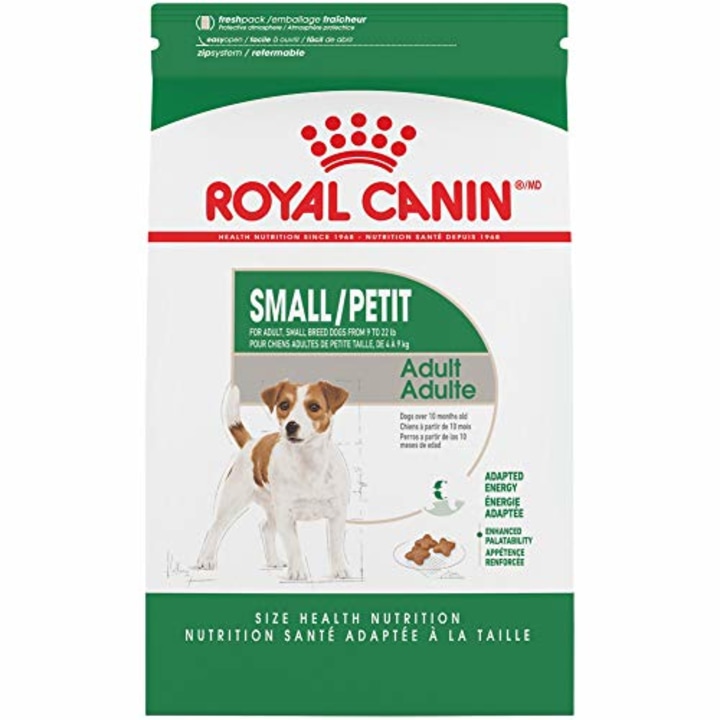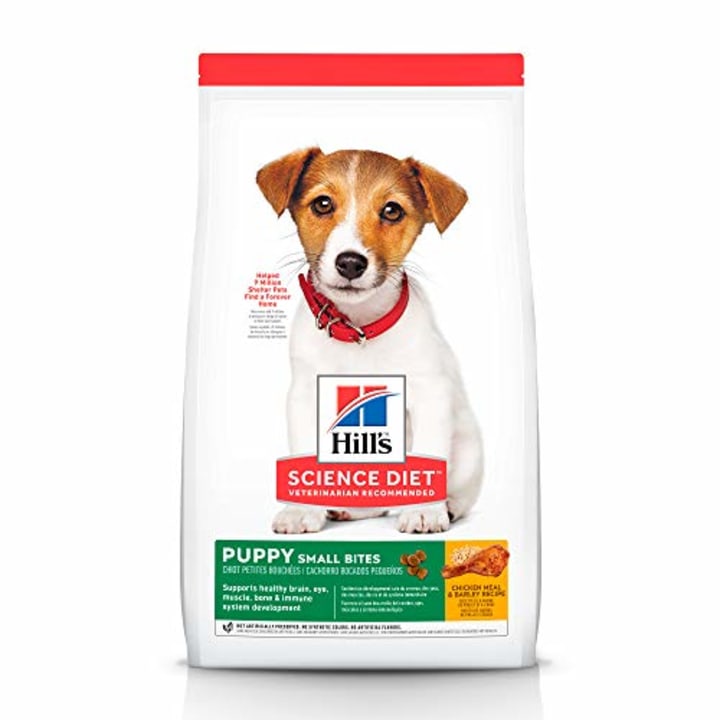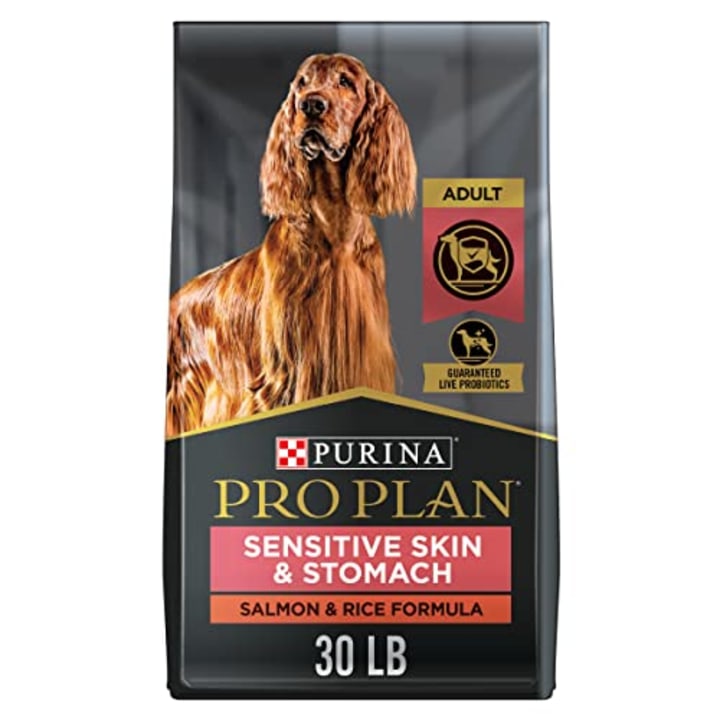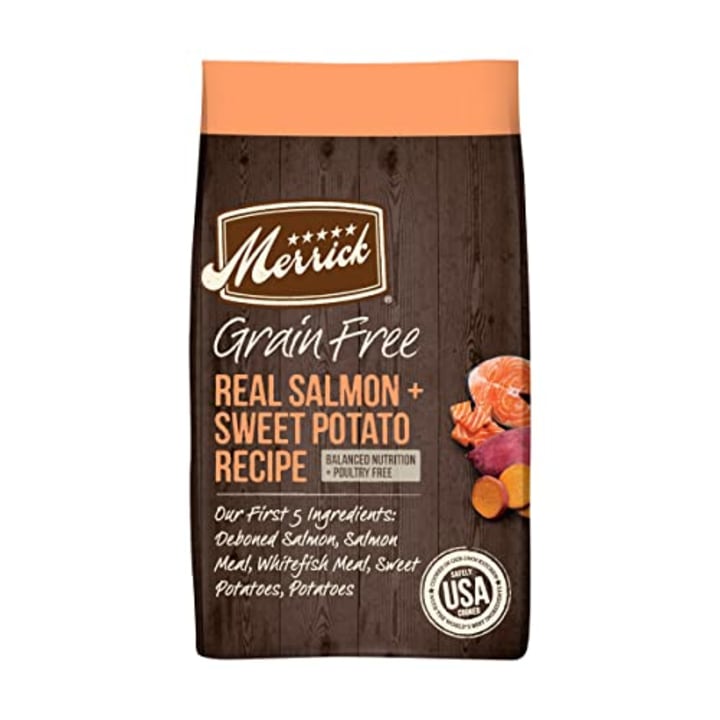In addition to providing a cozy bed and plenty of toys, feeding your dog a nutritious diet is one of the many responsibilities that come with being a pet parent. But selecting the right food for your pup is one of the most important decisions you can make as a pet owner: Experts told us the right food can not only lead to better absorption and digestion but also give your dog distinct health advantages.
“Commercially processed canned or kibble foods are formulated to meet dogs’ nutritional needs for proteins, fats, carbohydrates, vitamins and minerals — they’re convenient, consistent and readily available, and they undergo a process of quality control and inspection that is meant to catch any contaminants or pathogens before they affect pets or people,” explained Dr. Lori Teller, a board-certified veterinarian and president of the American Veterinary Medical Association.
LEARN MORE How to determine the best food for your dog | Wet versus dry food | Is a grain-free formula better for dogs? | Are raw food diets and supplements necessary?
As the number of dog-owning households grows in the U.S., it comes as no surprise that Americans are spending more on their furry friends’ diet. According to a recent survey by the American Pet Products Association, people spent upwards of $50 billion on food and treats for their pets in 2021 (up from $38 billion in 2020), with dog owners spending an average of $287 on food annually. Major pet supply retailers, like Chewy and Petco, have also seen a higher demand for premium dog food in the past year despite inflation concerns causing decreased spending on other essentials, like leashes and toys.
We consulted veterinarians and animal nutrition experts on what to keep in mind when shopping for the best dog food and compiled some highly rated options based on their guidance.
Best dog food to consider in April 2023
In line with our experts’ advice, all of the following highly rated dog foods — including dry kibble and canned wet food — meet or exceed the Association of Animal Feed Controls Officials (AAFCO) nutritional standards. They also come from brands that have a team of veterinary nutritionists on staff to regulate the use of high-quality ingredients, and each brand provides a feed guide on its packaging to help you determine the appropriate portions for your dog’s weight and size. All of the brands also offer high-calorie options for puppies and easily digestible kibble sizes for various sized dogs.
Best overall dry dog food: Royal Canin
Royal Canin Size Health Nutrition Small Adult Formula Dog Dry Food
Royal Canin offers some of the most diverse dog food options on the market — the brand makes both dry and wet food for a variety of dog sizes, breeds and dietary restrictions, including food sensitivities and gastrointestinal issues. I feed my 4-year-old Havachon, Bella, Royal Canin’s small-breed kibble — formulated for small dogs from 10 months old to 8 years that weigh 9 pounds to 22 pounds — after it was recommended by my veterinarian. Select’s manager of editorial operations Shari Uyehara says she also feeds her dog Loki, a 1-year-old cavalier King Charles spaniel, the same formula after it was recommended by Loki’s breeder. I’ve noticed that Bella prefers this brand over others, which she would often leave half-eaten. Royal Canin also offers its dry food formula for medium and large breeds, as well as a puppy formula.
Best subscription dog food: The Farmer’s Dog
The Farmer’s Dog Subscription Dog Food
There are several subscription home-delivery services for dog food, which regularly send bags of fresh food directly to your door. Dr. Judy Morgan, a veterinarian who specializes in integrative care, recommended The Farmer’s Dog, which she calls “TV dinners for dogs” due to their palatability. Select’s social editor Sadhana Daruvuri feeds The Farmer’s Dog to her 1-year-old Maltipoo, Bandit, and he loves it. “I knew friends who tried it, and their dogs were all big fans, so I did a trial with Bandit and it was obvious he liked it way more than his kibble,” she says. If you’re on a budget and have a large dog, this might not be a cost-effective option for you, but it may be more beneficial for owners of smaller dogs, Morgan says.

Best dog food for puppies: Hill’s Science Diet
Hill’s Science Diet Puppy Small Bites Dry Dog Food
Hill’s Science Diet’s dog food for puppies is designed for dogs up to 1 year old and is packaged in a small, easy-to-digest kibble, according to the brand. The formula contains natural DHA from fish oil that works to support healthy brain and eye development, as well as a vitamin E and vitamin C blend that helps support a healthy immune system in puppies, Hill’s Science Diet says. The food comes in a 4.5- or 15.5-pound bag, and the brand also offers a canned puppy formula, which our experts say can be great to mix into your dog’s kibble.
Best dog food for large breeds: Purina
Purina Pro Plan Adult Large Dry Dog Food
Purina says it employs several veterinary nutritionists to help determine healthy formulations and ingredients. The brand’s highly rated Pro Plan dog food is geared toward dogs of different sizes and in all stages of life, including large-breed adults and puppies, according to Purina. The Purina Pro Plan formula contains natural prebiotic fiber for digestive health, and omega-6 fatty acids and vitamin A for skin and coat health, according to the brand. Select’s associate updates editor Zoe Malin says her large 100-pound yellow lab Chance eats the weight-management dry kibble from the brand, which Purina says contains a more optimized protein-to-fat ratio, since he’s 9 years old and less active now.
Best frozen dog food: Just Food For Dogs
Just Food For Dogs Fish & Sweet Potato
Just Food For Dogs is designed to be high in protein and low in calorie count, so it can be beneficial for dogs who may be overweight or don’t get regular exercise, according to the brand. It offers a variety of meal options that are made up of locally sourced produce and only one source of protein for a limited ingredients diet.
This sweet potato and fish option provides a balanced diet for dogs with sensitive stomachs or those in need of a novel protein due to allergies, Just Food For Dogs says. The brand offers two types of food: Fresh Frozen, which has no preservatives and can be thawed and served, and Pantry Fresh, which is shelf-stable for up to two years and doesn’t require refrigeration, according to the brand.
Best dog food for sensitive stomachs: Purina
Purina Pro Plan Adult Sensitive Skin & Stomach Dry Dog Food
Some dogs are sensitive to certain food ingredients, which can cause excessive itching, loose stools, occasional vomiting and other symptoms. Investing in a dog food formulated for dogs with sensitive stomachs and skin can help minimize these issues. This option from Purina is crafted without corn, wheat or soy to make it more easily digestible for dogs with an intolerance to these ingredients. However, experts told us these types of ingredients should only be avoided if your dog has an intolerance, as they are full of healthy vitamins, minerals and carbohydrates. To help your dog maintain a complete and balanced diet, the brand says the formula contains high-protein salmon, probiotics and prebiotic fiber for digestive and immune health and omega-6 fatty acids to help support a healthy skin and coat.
Best poultry-free dog food: Merrick
Merrick Grain Free Real Salmon & Sweet Potato Dry Dog Food
Former Select editor Morgan Greenwald gives Merrick’s salmon and sweet potato kibble to her 1-year-old pit bull mix, Suzie, since she can’t tolerate some other types of protein. “She gobbles it down and she does great with it — she has a sensitive tummy and her vet said we should avoid chicken and turkey, so I stick to salmon,” Greenwald says, adding that she likes the sweet potato in the formula “because it’s good for dogs’ digestion.”
The experts we spoke to agree: Studies show that proteins like beef and chicken are among the most reported causes of allergies in dogs, so it’s important to look out for common signs of allergies — like excessive itching and vomiting — to figure out what works best for them, says Dr. Joe Wakshlag, professor of clinical nutrition and sports medicine and rehabilitation at Cornell College of Veterinary Medicine. However, most dogs don’t usually experience these types of allergies, so you don’t need to avoid chicken and turkey unless you think your dog may have an allergy or intolerance.
Best wet dog food: Royal Canin
Royal Canin Adult Gastrointestinal Canned Dog Food
If you prefer to incorporate canned food into your dog’s meals, Royal Canin offers a variety of wet food options tested by veterinary nutritionists that can help you provide them with a little more diversity at dinnertime. Though it’s on the pricier side, this low-fat option can be good for adult dogs with gastrointestinal issues or digestive sensitivities, according to the brand. The formula contains prebiotics to help maintain good bacteria in the gut, a blend of dietary fibers that can promote healthy digestion and omega-3 fatty acids from fish oil to help soothe the GI tract, according to Royal Canin.
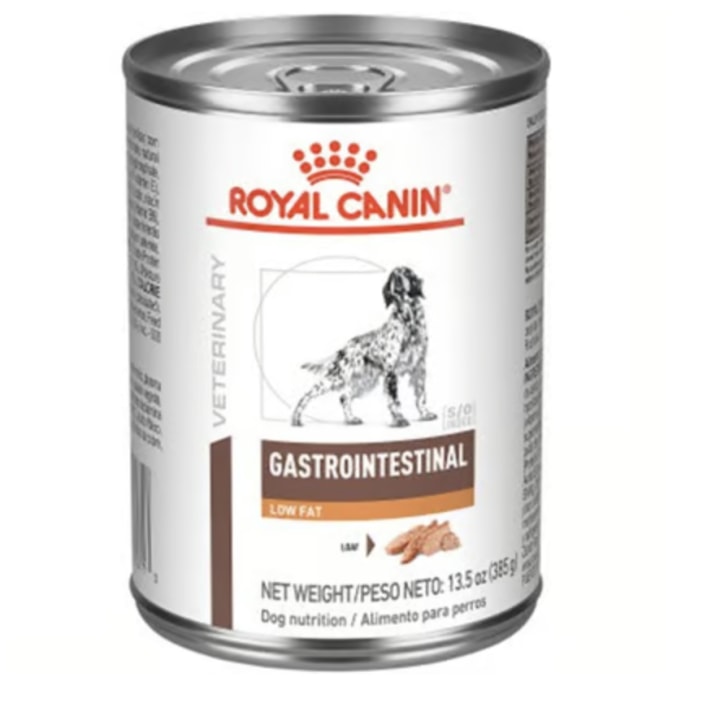
How to determine the best food for your dog
The two biggest factors that determine whether your dog’s food is good for their health is whether it’s nutritionally complete and balanced and whether you’re giving your dog the right proportions based on their size and weight. “Overall, when selecting your pet’s food, it is important to consider the information on the label and information beyond the label,” says Dr. Megan Shepherd, a board-certified veterinary nutritionist and owner of Veterinary Clinical Nutrition, PLLC.
On the label, the nutrition adequacy — or the AAFCO statement — indicates the species and life stage the food is formulated for and how it’s substantiated, either by formulation or feeding tests. But what isn’t on the label can be equally as important. The Global Nutrition Guidelines set by the World Small Animal Veterinary Association (WSAVA) recommend investigating the brand to determine the people involved in the product’s formulation and manufacturing and whether the company routinely analyzes its finished products for nutrient content, pathogens and other items that don’t belong in dog food.
“Do they have veterinarians on staff or, more specifically, do they have veterinary nutritionists who are board-certified in that field? Brands that provide the best diets also invest in research,” says Dr. Brian Roberts, a board-certified veterinarian and regional medical director in the Mid-Atlantic region with VCA Animal Hospitals.
Below, we break down some key considerations experts suggest when shopping for high-quality dog food.
Meeting AAFCO nutrition standards
Our experts all agreed that any good dog food will meet the AAFCO nutrition standards. “You can determine if a pet food meets your pet’s nutritional needs by looking at the nutritional adequacy statement on the label — if this statement includes the phrase ‘complete and balanced,’ then the product is intended to be fed as a pet’s sole diet and should be nutritionally balanced,” Roberts says.
“We have the AAFCO to make sure that everything you feed [your dog] is a form of dog food that’s nutritionally complete,” Wakshlag says. You should be able to find the statement — which the FDA considers one of the most important aspects of a dog or cat food label — on the back label (in small font).
While AAFCO has feed control officials that develop standards, definitions and policies for the sale and distribution of pet food, among other animal feeds, the voluntary membership association doesn’t regulate, test, approve or certify pet food, so there’s no such thing as an “AAFCO approved” brand or product.
Ingredients and palatability
Finding the best food for your dog is much less about the specific ingredients than you may think. Dr. Richard Hill, a board-certified veterinary nutritionist and associate professor at the University of Florida Department of Small Animal Clinical Sciences, told us dog owners should focus on the nutrients their companion is getting from those ingredients instead.
However, the ingredient list can give you an idea of what nutrients your dog can get from their meal. The AAFCO states that an ingredient list is required to display all ingredients from highest amount to least amount by weight, which means the first three listed are the most critical — this will help you determine if the formula is vegetable-based with things like corn and rice or meat-based with chicken, fish or lamb, experts told us.
AAFCO has developed several safety standards for ingredients used in pet food, and the association goes into depth about common pet food labels.
- Organic food needs to follow production and handling requirements set by the USDA’s National Organic Program — which regulates all organic crops, livestock and agricultural products — to be recognized by the association.
- Human-grade has no real definition in any animal feed regulations because very few pet food products can be officially considered edible by humans, AAFCO says.
- Natural food has to be derived solely from plant, animal or mined sources and cannot be produced by a chemically synthetic process (although ingredients can contain trace amounts of chemically synthetic compounds and still be considered natural).
“Some say natural ingredients like whole chicken are better than something processed like chicken meal; however, both are from the same source — chicken meal is just dehydrated chicken,” Roberts says.
There are some ingredients that you should avoid, though — the main one that’s commonly seen in commercial pet food is garlic powder. Garlic is a palatant, which means it’s designed to make the food taste better, according to Shepherd — however, it can be dangerous. “While the amount of garlic in pet food and treats may be below the level that could cause anemia, garlic still causes red blood cell oxidation — I recommend avoiding products that contain garlic powder,” she says.
Nutritional value and proportions
To make sure you’re giving your dog the appropriate nutrients and proportions, Shepherd recommended first checking the food’s energy density — which is shown as kcal (calories) per cup, can or ounce, similar to the nutritional facts on human foods — and its feeding guidelines. Once that’s determined, you can keep an eye on your pet’s weight with the Body Condition Score, which is a visual scale that evaluates the amount of fat on key parts of the dog’s body (a 4 or 5 score is ideal).
Unfortunately, the No. 1 nutritional disease in dogs is obesity and, in some breeds, this can take as much as two years off their lifespan, according to Hill. A lot of obesity problems in dogs come down to the owner’s inability to understand their dog’s calorie intake. “We just pay attention to what’s on the side of the bag and those recommendations are pretty much for the normal, active dog — a lot of dogs just aren’t normal and active,” Wakshlag says. “That’s one thing to consider that’ll help your dog live longer: It’s not necessarily about what you’re feeding them, it’s how much you’re feeding them,” Hill notes.
Your dog’s size, weight and life stage
Generally, your dog’s food should match their life stage. For example, you should feed your puppy food that has the puppy label until they reach their adult body weight — small breeds can switch to adult food at seven to nine months, while bigger breeds typically switch at 12 to 14 months, according to the American Kennel Club.
“Puppy food is appropriate for adult dogs only if the adult dog will not become overweight on a higher calorie food,” Shepherd says. When it comes to the later stages of your dog’s life, if your senior dog is healthy and eating a nutritionally balanced diet, there is no need to change their food, according to Tufts University Cummings School of Veterinary Medicine.
You’ll often see certain dog foods labeled for small, medium and large breeds — these labels mostly deal with the size of the kibble and whether it’s easy for them to ingest. Some brands like Royal Canin offer breed-specific formulas, which can help certain breeds’ needs. “Manufacturers that follow nutritional science have developed diets with ingredient content for specific classes of breeds who are predisposed to certain problems. Many large and giant breeds can develop joint problems in life — some of which are linked to certain ingredients — and diets labeled ‘giant breed’ take this into consideration,” Roberts says.
Wakshlag suggested being mindful of whether the formulas are actually beneficial or just marketing tactics, noting that you should double-check the ingredients list and nutritional content to make sure the food is actually serving its purpose for your breed.
Wet versus dry food: What’s the difference?
The main difference between dry food and canned dog food is its water content. “Kibble is 10{7b6cc35713332e03d34197859d8d439e4802eb556451407ffda280a51e3c41ac} water, [while] canned food is upwards of 70{7b6cc35713332e03d34197859d8d439e4802eb556451407ffda280a51e3c41ac} water,” Roberts says. If both products have the same ingredients and only the water content differs, he noted it’s okay to mix the wet food with your dog’s dry kibble, especially if they often get picky about their food or need an extra boost of hydration. You can also add fresh dog-safe vegetables and fruits to their meals (or as treats) to add nutritional value without adding the calories (as long as they’re still getting their normal kibble), Wakshlag says.
Dry food is also more economical and typically much more stable if it’s stored in its original container in a dry location compared to wet food, which perishes at room temperature after opening, according to Shepherd. (For food safety purposes, Hill recommended storing your dog’s kibble in a cool, dry environment to prevent it from going bad and completely cleaning out the bag or reusable container before putting new kibble on top.)
Shepherd added that a sole wet food diet can be helpful for dogs who can no longer chew kibble due to dental disease or dogs who may benefit from a higher moisture diet due to health conditions, like chronic recurrent urinary issues.
Is a grain-free formula better for dogs?
A grain-free formula is made without wheat, barley, rye and corn, and it’s commonly fed to dogs with a gluten intolerance. However, a grain-free diet isn’t better for your dog — and feeding grain-free kibble to your dog can sometimes prevent them from getting their appropriate daily nutritional intake.
“Although often seen in humans, actual cases of true gluten intolerance in dogs and cats are quite rare,” says Roberts, adding that the aforementioned ingredients aren’t just filler ingredients. “Carbohydrates — and corn especially — provide calories, extra fiber for better digestion, important vitamins and minerals and antioxidants,” he says. Hill echoed the importance of carbs in your dog’s diet: “There’s no reason why animals shouldn’t consume a reasonable amount of carbohydrates — [they’re] okay in moderation.” Plus, grain-free foods will usually use other sources of carbohydrates in place of grain — including potatoes and legumes — so the formula will very rarely be low in carbs despite the brand’s marketing, Hill explained.
Research has found an association between some grain-free diets and dilated cardiomyopathy in some dogs, but the cause for the association is still under investigation by the FDA. “We don’t know if there are ingredients to avoid or if it is due to an overall quality control issue,” Shepherd says. Wakshlag notes that it may not be the grain-free foods that are causing these issues, but rather the dogs themselves may be predisposed.
Are raw food diets and supplements necessary?
Typical dog food, whether it’s basic dry kibble or a combination of kibble with wet food, is specifically designed to meet your dog’s nutritional needs. Some dog owners will feed their dogs a raw food diet — which can be homemade, freeze-dried and dehydrated — and this typically consists of everything from raw meat and eggs to dog-safe fruits and vegetables. But our experts advised against it: “The AVMA discourages feeding dogs any animal-source protein that has not first been subjected to a process to eliminate pathogens because of the risk of illness to cats and dogs as well as humans,” Teller says.
Raw meat-based diets can also produce a higher risk of microbial pathogens, antibiotic resistance genes and other anti-nutritional factors, according to Shepherd. This also goes for freeze-dried meat products that typically get mixed in with kibble as “boosters” — “they should be considered raw as freeze-drying does not eliminate pathogens,” Shepherd says. And if your pet is eating a complete and balanced commercially available pet food, supplements are not recommended unless specifically prescribed by your veterinarian, Teller noted.
Catch up on Select’s in-depth coverage of personal finance, tech and tools, wellness and more, and follow us on Facebook, Instagram and Twitter to stay up to date.


